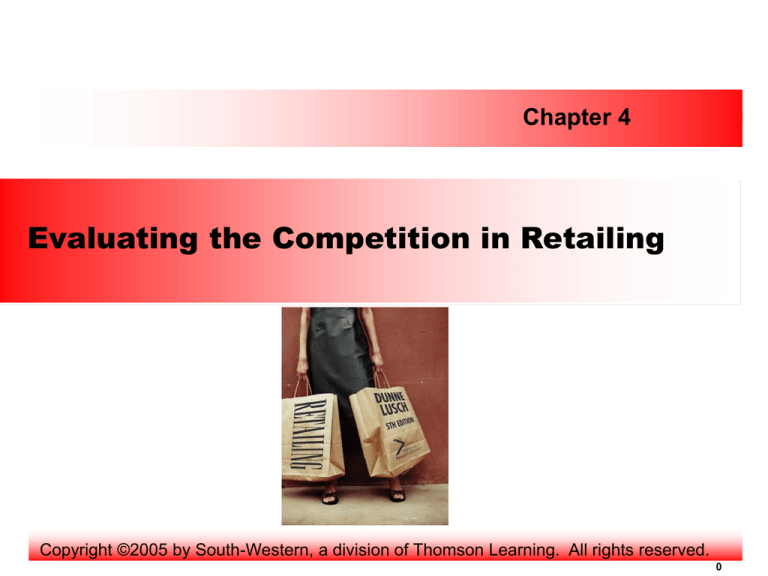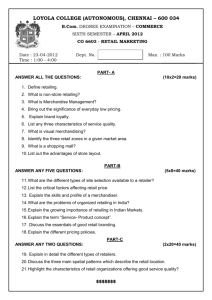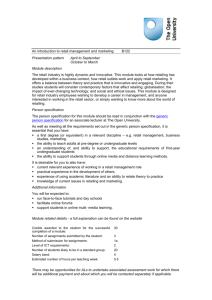
Chapter 4
Evaluating the Competition in Retailing
Copyright ©2005 by South-Western, a division of Thomson Learning. All rights reserved.
0
Learning Objectives
• Explain the various models of retail competition
• Distinguish between various types of retail
competition
• Describe the four theories used to explain the
evolution of retail competition
• Describe the changes that could affect retail
competition
1
Models of Retail Competition
LO 1
•
•
•
•
•
•
•
The Competitive Marketplace
Market Structure
The Demand Side of Retailing
The Supply Side of Retailing
The Profit-Maximizing Price
Nonprice Decisions
Competitive Actions
2
The Competitive Marketplace
LO 1
While retailers typically compete for customers on a
local level, catalog and electronic retailers compete at
national and international levels.
3
Market Structure
LO 1
Pure Competition
Pure Monopoly
Monopolistic Competition
Oligopolistic Competition
4
Market Structure
LO 1
Pure Competition
Occurs when a market has homogenous products and
many buyers and sellers, all having perfect knowledge
of the market, and ease of entry for both buyers and
sellers.
5
Market Structure
LO 1
Pure Monopoly
Occurs when there is only one seller for a product or
service.
6
Market Structure
LO 1
Monopolistic Competition
Occurs when the products offered are different, yet
viewed as substitutable for each other and the sellers
recognize that they compete with sellers of these
different products.
7
Market Structure
LO 1
Oligopolistic Competition
Occurs when relatively few sellers, or many small
firms who follow the lead of a few larger firms, offer
essentially homogeneous products and any action by
one seller is expected to be noticed and reacted to by
the other sellers.
8
Market Structure
LO 1
Outshopping
Occurs when individuals in one community travel
usually to a larger community to shop.
9
The Demand Side of Retailing
LO 1: Exhibit 4.1
Price
Demand as a Function of Price
Quantity Demanded
10
The Supply Side of Retailing
Dollars
Fixed Costs
LO 1
Unit Sales Quantity or Sales Volume
11
The Supply Side of Retailing
Dollars
Variable Costs
LO 1
Unit Sales Quantity or Sales Volume
12
The Supply Side of Retailing
Dollars
Total Costs
LO 1
Unit Sales Quantity or Sales Volume
13
The Profit-Maximizing Price
LO 1
• A profit-maximizing price seeks to get as much profit
as possible from the sale of each unit.
14
Nonprice Decisions
LO 1
• Nonprice competition strategies
• Position itself as different from the competition by
altering its merchandise mix to offer higher quality
goods, great personal service, etc.
• Offering private label merchandise.
• Provide free services or products, such as free gas to
out of town customers.
• Strive to always have basic merchandise in stock.
15
Nonprice Decisions
LO 1
• Store Positioning
Is when a retailer identifies a well-defined market
segment using demographic or lifestyle variables and
appeals to this segment with a clearly differentiated
approach.
16
Nonprice Decisions: Private Labels of
Major Retailers
LO 1: Exhibit 4.2
• Kmart: Joe Boxer, Martha Stewart Everyday, Disney
• Sears apparel brands: Apostrophe, TKS, Land’s End
• JCPenny: St. John’s Bay, Arizona, Stafford
• Wal-Mart: Equate, Simply Basic, Great Value
• Target:
Cherokee, Honors, Furio
• Saks Fifth Avenue: 5/48, Real Clothes, SFA Collections
• Federated Department Stores: I.N.C., Alfani, Green Dog
• Nordstrom: BP, Halogen, Studio 121
• Lord and Taylor: Katie Hill, Context, Identity
17
Competitive Actions
LO 1
Competitive activity can be examined by the number of
retail establishments of a given type per thousand
households.
18
Competitive Actions
LO 1
• Overstored
Is a condition in a community where the number of
stores in relation to households is so large that to
engage in retailing is usually unprofitable or
marginally profitable.
• Understored
Is a condition in a community where the number of
stores in relation to households is relatively low so
that engaging in retailing is an attractive economic
endeavor.
19
Types of Competition
LO 2
• Intratype and Intertype Competition
• Divertive Competition
20
Types of Competition
LO 2
• Intratype Competition
Occurs when two or more retailers of the same type as
defined by NAICS codes in the Census of Retail Trade,
compete directly with each other for the same
households.
• Intertype Competition
Occurs when two or more retailers of a different type,
as defined by NAICS codes in the Census of Retail
Trade, compete directly by attempting to sell the same
merchandise lines to the same households.
21
Intratype and Intertype Competition
LO 2
• Intratype competition for books.
22
Intratype and Intertype Competition
LO 2
Intertype competition for video rentals.
23
Intratype and Intertype Competition
LO 2
Intertype Competition
Supermarkets offering
Home Meal
Replacements (HMR)
compete with fast-food
restaurants
Albertsons
Supermarket
McDonald’s
Food Giant
Supermarket
Intratype Competition
24
Types of Competition
LO 2
Divertive Competition
Occurs when retailers intercept or divert customers
from competing retailers.
25
Types of Competition
LO 2
Break-even Point
Is where total revenues equal total expenses and the
retailer is making neither a profit nor a loss.
26
Evolution of Retail Competition
LO 3
• The Wheel of Retailing
• The Retail Accordion
• Retail Life Cycle
27
Evolution of Retail Competition
LO 3
• The Wheel of Retailing Theory
Describes how new types of retailers enter the market
as low-status, low-margin, low-price operators;
however, as they meet with success, these new
retailers gradually acquire more sophisticated and
elaborate facilities, and thus become vulnerable to new
types of low-margin retail competitors who progress
through the same patter.
28
The Wheel of Retailing Theory
LO 3: Exhibit 4.3
29
Wheel of Retailing
LO 3
Some would argue that
McDonald’s has become
a victim of the wheel of
retailing. When
McDonald’s started out,
it served a select menu.
Over the years, the
McDonald’s product
offering has expanded to
the inclusion of
playgrounds, thus
opening the way for new,
low-cost fast-food
providers, such as
Checkers.
30
Evolution of Retail Competition
LO 3
Retail Accordion
Describes how retail institutions evolve from outlets
that offer wide assortments to specialized stores and
continue repeatedly through the pattern.
31
The Retail Accordion
LO 3
Wide Assortment
Time
Narrow
Assortment
Wide Assortment
32
Evolution of Retail Competition
LO 3
Retail Life Cycle
Describes four distinct stages that a retail institution
progresses through:
Introduction
Growth
Maturity
Decline
33
Evolution of Retail Competition:
The Retail Life Cycle
LO 3
Introduction
Begins with an aggressive, bold entrepreneur who is
willing and able to develop a different approach to
retailing of certain products. During this stage profits
are low, despite increasing sales levels.
34
Evolution of Retail Competition:
The Retail Life Cycle
LO 3
Growth
Sales and profits explode, validating the
entrepreneur’s good idea. New retailers enter the
market and begin to copy the retailers idea. Late in this
stage both market share and profitability approach
their maximum levels.
35
Evolution of Retail Competition:
The Retail Life Cycle
LO 3
Maturity
Market share stabilizes and profits decline because:
•
managers use to managing simple small
retail outlets must now manage large complex
firms,
•
industry has overexpanded, and
•
competitive assaults by new retail
formats.
36
Evolution of Retail Competition:
The Retail Life Cycle
LO 3
Decline
The once promising idea is no longer needed in the
marketplace. As a result, market share and profits fall.
37
Retail Institutions in the Four Stages of
The Retail Life Cycle
Introduction
E-tailing
(1990’s)
Recyclers
(2000’s)
Growth
Food Courts
(1980’s)
Airport-based
retailers
(1980’s)
Supercenters
(2000’s)
LO 3: Exhibit 4.4
Maturity
Warehouse
clubs(1970’s)
Department stores
(1860’s)
Supermarkets (1930’s)
Convenience stores
(1960’s)
Category killers (1970’s)
Fast food (2000’s’)
Decline
Variety Stores
(1890’s)
Factory outlet
malls (1970’s)
Department
stores (2000’s)
38
Resource-Advantage Theory
LO 3
Resource-advantage theory
Is based on the idea that all firms seek superior
performance in an ever-changing environment.
• Illustrates two important lessons for retailers:
• Superior performance at any point in time is a result of
achieving a competitive advantage in the market place
as a result of some tangible or intangible entity
(“resource”).
• All retailers cannot achieve superior results at the
same time.
39
Future Changes in Retail Competition
LO 4
•
•
•
•
•
Nonstore Retailing
New Retail Formats
Heightened Global Competition
Integration of Technology
Increased use of Private Labels
40
Future Changes in Retail Competition
LO 4
• Nonstore Retailing
Direct selling
Catalog sales
E-tailing
41
Future Changes in Retail Competition
LO 4
New Retail Formats
Supercenters
Recycled Merchandise Retailers
Liquidators
42
Future Changes in Retail Competition:
New Retail Formats
LO 4
Off-price Retailers
Sell products at a discount but do not carry certain
brands on a continuous basis. They carry those
brands they can buy from manufacturers at closeout
or deep one-time discount prices.
43
Future Changes in Retail Competition:
New Retail Formats
LO 4
Supercenters
Combine a discount store and grocery store to carry
80,000 to 100,000 products in order to offer one-stop
shopping.
44
Future Changes in Retail Competition:
Supercenters
LO 4
Number of Supercenters by Retailer
1998
1999
2000
Wal-Mart
564
721
894
Meijer
117
127
144
Kroger
105
126
135
Kmart
102
105
115
Target
14
16
31
45
Future Changes in Retail Competition:
New Retail Formats
LO 4
Recycled Merchandise Retailers
Are establishments that sell used and reconditioned
products.
46
Future Changes in Retail Competition:
New Retail Formats
LO 4
Liquidators
Liquidates leftover merchandise when an established
retailer shuts down or downsizes.
47
Leading U.S. Retailers by Sales
LO 4
$200B
$30B
$10B
Sears
Wal-Mart
$5B
K-Mart
A&P
$800M
$500M
$200M
1900
’20 ’30 ’40 ’50 ’60 ’70 ’80 ’90 2000
48
The Relationship of Price Versus
Nonprice Actions and Demand Curve
LO 4
Price
Price
D1
Quantity
Pricing Actions move
the consumer up and
down the current
demand curve.
D2
Quantity
Non-price Actions
seek to shift the
demand curve to right
and make it more
inelastic.
49
Future Changes in Retail Competition
LO 4
Heightened Global Competition
Increasing Rate of Change
Greater Diversity
Creation of New Retail Formats
50
Future Changes in Retail Competition
LO 4
Integration of Technology
Supply Chain Management
Customer Management
Customer Satisfaction
51
Future Changes in Retail Competition
LO 4
Increasing Use of Private Labels
Helps in protecting retailer niche
Sets retailer apart from competition
52
Arizona Jeans Co.
LO 4
JCPenney has built
significant store loyalty
through the introduction
and development of the
private label brand
Arizona Jeans Co.
53
Question to Ponder
• Should retailers advertise the fact that they are the
owners of the private label brand(s) they sell?
54
Future Changes in Retail Competition
LO 4
• Private Label Branding Strategies
• Developing a partnership with well-known celebrities,
noted experts, and institutional authorities.
• Developing a partnership with traditionally higher-end
suppliers to bring an exclusive variation on their
highly regarded brand name to the market.
• Reintroducing products with strong name recognition
that have fallen from the retail scene.
• Branding an entire department or business; not just a
product line.
55
Additional Slides
56
Market Structure
LO 1
Monopolistic
Pure
Competition Competition
Retail
Competition
Oligopolistic
Competition
Pure
Monopoly
57
Future Changes in Retail Competition
LO 4
Nonstore
Retailing
New Retail
Formats
Heightened
Global
Competition
Integration of
Technology
Increased use
of Private Labels
58
Future Changes in Retail Competition:
Nonstore Retailing
LO 4
Direct
Selling
Catalog
Sales
E-tailing
59
Future Changes in Retail Competition:
New Retail Formats
LO 4
Supercenters
Recycled
Merchandise Liquidators
Retailers
60
Future Changes in Retail Competition:
Heightened Global Competition
LO 4
Increased
Rate of
Change
Greater
Diversity
Creation of
New Retail
Formats
61
Future Changes in Retail Competition:
Integration of Technology
LO 4
Supply Chain
Management
Customer
Customer
Management Satisfaction
62







